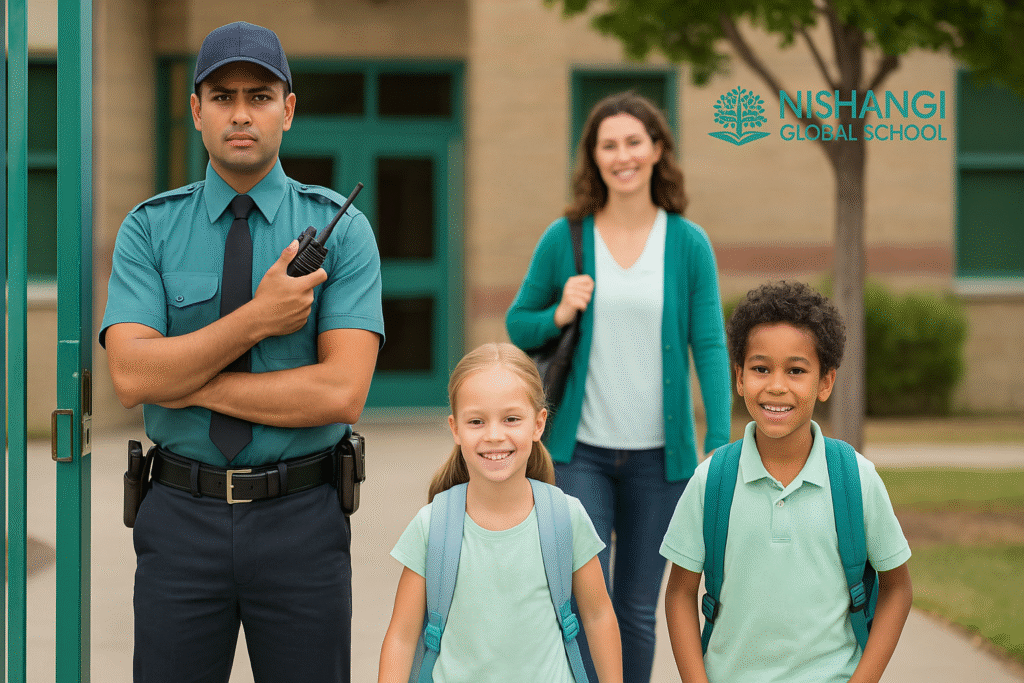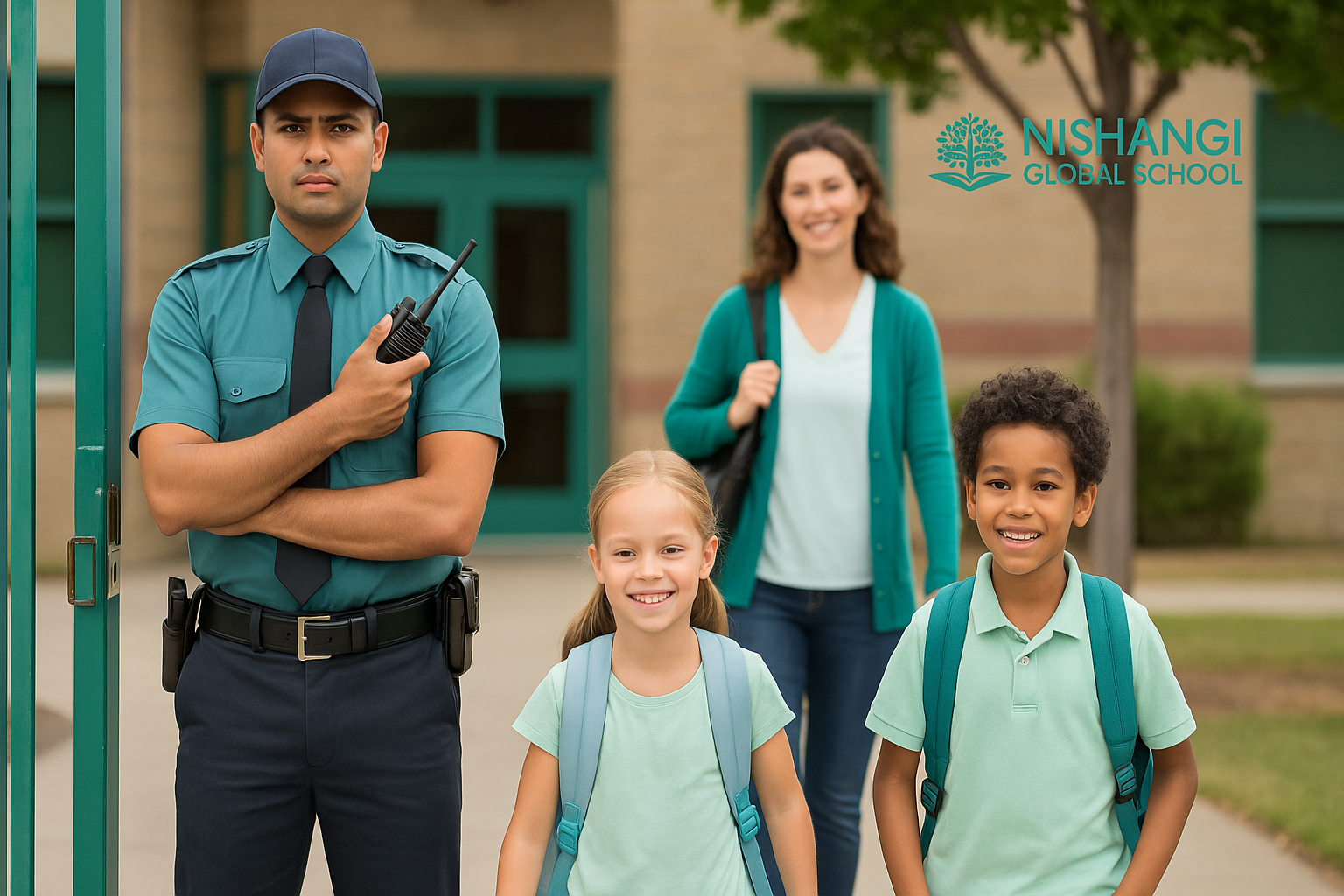
When parents entrust their child to a school, the first thing they hope for—even before academic excellence—is peace of mind. At Nishangi Global School, safety and security are not afterthoughts: they are integral parts of our identity. Every day, every policy, every facility is shaped to ensure that our students can learn, explore, and grow without fear. Let us take you through how we implement safety at every level—why each measure matters, how we do it, and how it works together to protect our school community.
Why Safety & Security Are Non‑Negotiable
Few things matter more than safeguarding the physical and emotional well‑being of our students. When children feel safe, they behave better, learn more, and participate more fully. A secure environment builds trust between the school, students, and parents. It allows teachers to teach without distractions, and students to learn without constant worry. Emergencies may be rare, but being prepared means they cause less harm.
At Nishangi, from early grades to secondary, we believe in holistic development—intellectual, emotional, physical, and moral. A strong safety foundation is essential to that holistic growth. Our motto isn’t just about infrastructure or rules—it’s about creating a culture of care.
The Pillars of Our Safety & Security System
We implement safety and security across multiple domains. Here are the key pillars:
- Surveillance & Access Control (CCTV, Gate Security, Controlled Entry)
- Emergency Preparedness (Fire Safety, Drills, Evacuation)
- Transport Safety (Buses, GPS Tracking, Supervision)
- Staff Background Verification & Continuous Screening
- Health, Hygiene, and Campus Safety (Washrooms, Lifts, Cleanliness)
- Parent & Community Involvement
Let’s dive into each, highlighting what we do at Nishangi with real examples and anchor text links.
1. Surveillance & Access Control
What and Why
CCTV monitoring, secure gates, and controlled visitor access are among the first lines of defense in school security. They deter wrongdoing, help monitor daily movement, provide evidence in case of incidents, and ensure only authorized individuals enter student zones.
How Nishangi Implements It
- The campus is under CCTV monitoring for a safe & secure premises, covering entrances, corridors, common spaces, playground edges, and outdoor areas.
- Trained security personnel are stationed at all gates and entry points. They check visitors, verify identity, ensure no unauthorized access.
- Doors, gates, and fences are maintained to avoid weak spots. CCTV cameras are regularly inspected to ensure they cover blind spots and are functional.
- Only authorized school administrators and security staff can access recorded footage under defined policies.
2. Emergency Preparedness
Fire Safety, Drills, and Evacuation Planning
- Emergencies—whether fire, natural disaster, or other crises—are unpredictable. Without clear protocols and regular drills, chaos can follow.
- At Nishangi, advanced fire safety measures are part of the curriculum. We conduct fire drills with students and staff, maintain equipment such as extinguishers and alarms, mark exits and staircase routes clearly.
- Evacuation plans are posted in every classroom, corridor, and public area so that in case of an emergency everyone knows where to go and how. Teachers are trained in taking attendance during evacuation and in helping younger students.
- Regular training ensures staff are ready to respond: who leads the group, how to guide students, what to check, and how to help if someone is injured or unable to move fast.
3. Transport Safety: Secure Journeys Every Day
Transport is a critical phase of the day: entering and exiting the school gates, riding the bus, waiting at stops. Any weaknesses here can compromise safety.
Our Measures at Nishangi
- Nishangi’s fleet of buses is fitted with GPS, allowing real‑time tracking of routes and speeds. Parents and school administrators can monitor to ensure the routes are safe and enables swift response in case of deviations.
- Each bus has a lady conductor on board to supervise safety during boarding, transit, and de‑boarding. This extra supervision helps younger students feel secure and ensures discipline and order.
- Vehicles are regularly serviced. Drivers are selected carefully, undergo verification and trained in safety norms, including speed limits, emergency stops, and proper conduct.
- Clear protocols exist for emergencies during transit, like medical incidents or route blockages. Communication channels between driver, school, and parents are well defined.
4. Staff Background Verification & Continuous Screening
You may have the best buildings and technology, but people make the school. Ensuring they have integrity, reliability, and a clean record is essential.
What Nishangi Does
- Every staff member— teaching, administrative, security, transport, support staff—goes through compulsory background verification including police checks. This verification isn’t just once: it’s repeated annually to ensure continued trust.
- Non‑teaching staff and bus drivers are subject to the same rigor as teaching staff. No one interacts with students without vetting.
- There is also regular observation of staff behaviour, feedback systems, and accountability. If there are concerns from students, parents, or staff, those are taken up promptly.
5. Health, Hygiene, and Campus Safety Details
Safety involves more than protection against external threats—it includes ensuring everyday spaces are safe, clean, and conducive to health.
Specific Practices
- Washrooms, drinking water points, and common areas are sanitized regularly. Cleanliness is ensured both for hygiene and safety.
- Lift safety: lifts (if present) are regularly inspected, maintained, and have emergency buttons. Ensuring safety in mechanical facilities means proper maintenance schedules and checks.
- Campus safety includes well‑lit corridors, secure fencing, no open access to restricted areas, clear signage for fire exits, and navigating stairs safely.
- Counselling sessions: in addition to physical safety, students are educated on social behaviour, appropriate etiquette, preventing bullying, etc. This helps create a safe emotional climate.
6. Parent & Community Involvement
Safety isn’t the job of the school alone. When parents, students, staff, and the wider community are involved, the system is much stronger.
- Nishangi has a Parent Inspection Committee: parents are invited to visit the campus (short‑term or over a term) to observe safety procedures, suggest improvements in Transport, Dining, Housekeeping, etc.
- Transparency is encouraged: details of safety policies, staff checks, contact persons for safety concerns are made accessible.
- Feedback loops: students and parents can raise concerns, which are addressed. This helps identify blind spots and improve continuously.
Challenges & How We Address Them
Being safe isn’t always easy. Here are common challenges and our responses:
- Human error: Even with procedures, people can make mistakes. We mitigate via regular refresher trainings for staff and weekly checks for critical safety areas.
- Technology malfunction: Cameras, alarms, GPS systems may fail. We have scheduled maintenance, backups, and checklists to ensure redundancy.
- Budget constraints: Maintaining safety infrastructure costs money. The school allocates budgeting in advance for replacements, upgrades, and training.
- Compliance & Updates: Laws and norms evolve (CBSE, local authority, fire department regulations). We regularly review policies to align with current regulations.
Real‑Life Scenarios Show the Difference
- A student falls ill on the way home: GPS tracking allowed the school to know location, lady conductor alerted school nurse; parents contacted, medical support arranged.
- During a fire drill, one of the exits was found to be obstructed; immediate maintenance fixed the path; exit signage clarified.
- A parent in the inspection committee noticed wear in the bus harnesses; school replaced them ahead of schedule.
- During a rainy season, slippery stairs were identified; mats installed, stair‑rails cleaned and anti‑skid strips added.
These show that safety isn’t static—it’s responsive


